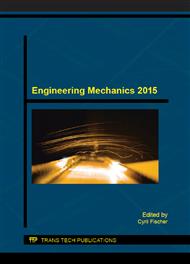[1]
H. Bolt, A. Brendel, D. Levchuk, H. Greuner, H. Maier, Materials for the plasma-facing components of fusion reactors, J. Nucl. Mater. 329–333 (2004) 66–73.
DOI: 10.1179/174892406x144451
Google Scholar
[2]
N. Yoshida, Review of recent works in development and evaluation of high-Z plasma facing materials, J. Nucl. Mater. 266-269 (1999) 197-206.
DOI: 10.1016/s0022-3115(98)00817-4
Google Scholar
[3]
D. Nishijima, M.Y. Ye, N. Ohno, S. Takamura, Incident ion energy dependence of bubble formation on tungsten surface with low energy and high flux helium plasma irradiation, J. Nucl. Mater. 99 (2003) 313–316.
DOI: 10.1016/s0022-3115(02)01368-5
Google Scholar
[4]
N. Yoshida, H. Iwakiri, K. Tokunaga, T. Baba, Impact of low energy helium irradiation on plasma facing metals, J. Nucl. Mater. 337 (2005) 946–950.
DOI: 10.1016/j.jnucmat.2004.10.162
Google Scholar
[5]
M. Efe, O. El-Atwani, Y. Guo, D.R. Klenosky, Microstructure refinement of tungsten by surface deformation for irradiation damage resistance, Scripta Mater. 70 (2014) 31–34.
DOI: 10.1016/j.scriptamat.2013.08.013
Google Scholar
[6]
M. Samaras, P.M. Derlet, H. Van Swygenhoven, M. Victoria, Radiation damage near grain boundaries, Philos. Mag. 83 (2003) 3599–3607.
DOI: 10.1080/14786430310001600222
Google Scholar
[7]
S.C. Cifuentes M.A. Monge P. Pérez, On the oxidation mechanism of pure tungsten in the temperature range 600–800°C, Corros. Sci. 57 (2012) 114–121.
DOI: 10.1016/j.corsci.2011.12.027
Google Scholar
[8]
A. Suslova, O. El-Atwani, D. Sagapuram, S. S. Harilal, A. Hassanein, Recrystallization and grain growth induced by ELMs-like transient heat loads in deformed tungsten samples, Sci. Rep. 4 (2014) 06845.
DOI: 10.1038/srep06845
Google Scholar
[9]
O. El-Atwani, G. Sean, E. Mert, G. De Temmerman, T. Morgan, K. Bystrov, D. Klenosky, Q. Tian, J. P. Allain, Ultrafine Tungsten as a Plasma-Facing Component in Fusion Devices: Effect of High Flux, High Fluence Low Energy Helium Irradiation, Nucl. Fusion, 54 (2014).
DOI: 10.1088/0029-5515/54/8/083013
Google Scholar
[10]
J. Tan, Z-J. Zhou, X-P. Zhu, S-Q. Guo, D-D. Qu, M-K. Lei, C-C. Ge, Evaluation of ultra-fine grained tungsten under transient high heat flux by high-intensity pulsed ion beam, T. Nonferr. Metal. Soc. 5 (2012) 1081−1085.
DOI: 10.1016/s1003-6326(11)61286-7
Google Scholar
[11]
K. Youngmoo, H.L. Kyong, Eun-Pyo K., D-I. Cheong, S.H. Hung, Fabrication of high temperature oxides dispersion strengthened tungsten composites by spark plasma sintering process, Int. J. Refract. Met. H. 27 (2009) 842–846.
DOI: 10.1016/j.ijrmhm.2009.03.003
Google Scholar
[12]
V. Barabash, G. Federici, R. Matera, A.R. Raffray, ITER Home Team, Armour Materials for the ITER Plasma Facing Components, Phys. Scr. 81 (1999) 74-83.
DOI: 10.1238/physica.topical.081a00074
Google Scholar
[13]
F. Koch, S. Köppl, H. Bolt, Self passivating W-based alloys as plasma-facing material, J. Nucl. Mater. 386–388 (2009) 572–574.
DOI: 10.1016/j.jnucmat.2008.12.179
Google Scholar
[14]
R. W. Cheary, A. Coelho, A fundamental parameters approach to X-ray line-profile fitting, J. Appl. Cryst. 2 (1992) 109-121.
DOI: 10.1107/s0021889891010804
Google Scholar
[15]
L. Veleva, R. Schaeublin, M. Battabyal, T. Plociski, N. Baluc, Investigation of microstructure and mechanical properties of W–Y and W–Y2O3 materials fabricated by powder metallurgy method, Int. J. Refract. Met. H. 50 (2015) 210-216.
DOI: 10.1016/j.ijrmhm.2015.01.011
Google Scholar
[16]
Z.M. Xie, R. Liu, S. Miao, T. Zhang, X.P. Wang, Q.F. Fang, C.S. Liu, G.N. Luo, Effect of high temperature swaging and annealing on the mechanical properties and thermal conductivity of W-Y2O3, J. Nucl. M. 464 (2015) 193-199.
DOI: 10.1016/j.jnucmat.2015.04.050
Google Scholar


